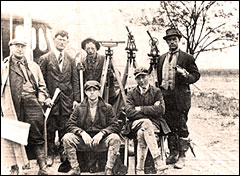Today, it’s almost impossible to say “Army Corps of Engineers” without also saying “Hurricane Katrina” and “levee failure,” or “Yazoo Pump” and “boondoggle.” But the corps’ original mandate made no mention of hurricane and flood protection, or even of the Mississippi River.

An Army Corps survey crew in 1916.
Photo: history.nasa.gov
In 1802, Congress established the Army Corps of Engineers as the nation’s design and construction crew. The country was barely a quarter-century past the Revolutionary War — where the first iteration of the corps had been assembled on the battlefield — and it needed a steady supply of engineers to map its assets and to build basic infrastructure such as forts, lighthouses, and roads.
At its inception, the corps consisted of a captain, two lieutenants, a math instructor, and 10 cadets. It was a far cry from today’s 35,000-member military and civilian organization, which has an annual operating budget nearing $38 billion.
Among the corps’ many early works are a series of forts maintained today as state and national landmarks, from Fort Adams in Rhode Island to Fort Jefferson off the coast of Florida, and even the fort at the base of the Statue of Liberty. The Cape Hatteras lighthouse, postcard-picture symbol of the Outer Banks, is an Army Corps project. Army engineers also designed and built many of the landmarks in the nation’s capital, including the Library of Congress, the Lincoln Memorial, and Rock Creek Park.
As the nation grew, the Army Corps saw its mission expand. Today, its duties encompass everything from maintaining aquatic resources across the country to cleaning up Superfund sites to building facilities for the Army and Air Force. And for more than a century, it has been building levees along the Mississippi River, the project for which it is perhaps best known — and most reviled — today.
Take Army to the River
With the Louisiana Purchase of 1803 — 828,000 square miles of French territory stretching from New Orleans, La., to what is today North Dakota — the size of the United States doubled, and the way to the West was opened. The acquisition ushered in a new era of national expansion, both geographically and commercially.
People were drawn to the “water highway” of the Mississippi, says Charles Camillo, historian for the Mississippi Valley Commission of the Army Corps in Vicksburg, Miss. And planters sought to farm the fertile land alongside the river, he says, but were wiped out with floods every spring. To stave off this seasonal onslaught, cities along the flood-prone river established local levee districts. Often funded through the sale of floodplain land to planters, these districts built their own levees according to their own requirements — and often with little concern for the levee’s effects downstream.

Craig Colten.
Photo: American University
This “solution” only worsened the flooding problem, says Craig Colten, professor of geography at Louisiana State University in Baton Rouge and author of An Unnatural Metropolis: Wrestling New Orleans from Nature. “Before levees, the flood would come and be a few inches to a few feet deep,” he says. “But after levees went up, floods would come through in a raging torrent.”
And so a debate sprang up in Congress: Should the federal government get involved in managing the Mississippi River? Were levees the best protection from flooding? And if they were, who should build and maintain them?
“Many in Congress had reservations about the Constitutional appropriateness of the federal government getting involved in flood control,” says Martin Reuss, retired senior historian of the Corps of Engineers and author of Designing the Bayous: The Control of Water in the Atchafalaya Basin, 1800-1995. “But they had no such problem with navigation.”
The Supreme Court ruled in 1824 that river navigation was directly tied to commerce and therefore should be maintained by the federal government, and not the states. While the case itself focused on competing steamboat operators’ access to a canal in upstate New York, the ruling set the stage for the feds to finance river improvements nationwide, including the Mississippi River, which was quickly becoming an important conduit for steamboats carrying agricultural goods. Soon, Congress charged the corps with the role of maintaining navigable waterways, emphasizing commerce on the entire Mississippi. Tree snags, sand bars, and other impediments to boat traffic had to be removed, and it became the corps’ responsibility to remove them.

Dam-building on the Mississippi in the late 1800s.
Photo: New York State Museum
As a result of this court case, the federal government appropriated $75,000 to the corps to improve navigation on both the Mississippi and Ohio Rivers, making the agency a fundamental force in controlling the Mississippi. Its power grew in 1879, when Congress established the Mississippi River Commission, a seven-member board whose members were chosen by the president. Although the MRC was supposed to balance civilian and Army engineering perspectives, Army officers outnumbered civilians on the board; an Army officer served as its president; and all these officers reported to the head of the corps. Ultimately the Army Corps controlled the civilian appointments as well.
The commission’s role was to both improve navigation and prevent floods. To meet these goals, it built a series of levees on the lower portions of the Mississippi. “Louisiana state engineers in the 1850s said the levees were making the floods worse,” Colten says. “There was a debate, but the proponents of a confined river won out.” That vital win would shape the future of the Mississippi region, and of the generations of residents who call the area home.
Of Levees and Locks
In the Great Flood of 1927, the Mississippi surged over its levee system in 145 locations, flooding 27,000 square miles at depths of up to 30 feet. The flood reached from Illinois to Louisiana, displacing 700,000 people and causing over $100 million (more than $1 billion in today’s dollars) in damage to crops and livestock. “The tremendous flood of 1927 showed the inadequacy of relying entirely on levees for flood control,” Reuss says.

The “Corps Castle” has been in use since 1839.
In response, Congress quickly passed the Mississippi River and Tributaries Act, changing the MRC into a strictly advisory body and giving the Army Corps of Engineers fundamental responsibility for maintaining flood control and navigation on the entire Mississippi. Congress authorized $325 million to the corps over 10 years — about one-tenth the entire federal budget at the time — to expand control of the river beyond levees. New measures would include dredging, channelization, and reservoirs, says Reuss.
“In terms of the future of the Mississippi, this was a very big deal,” says Reuss. “The plan that was passed in 1928 remains to this very day the template for developing the lower Mississippi in terms of navigation and flood control.”
While much of the flood-control legislation addressed the lower Mississippi, the corps’ influence reached all the way to the river’s headwaters, and had since the late 1800s. In fact, the corps built its first dam on the upper Mississippi in the 1880s — ostensibly to improve river navigation, but also to provide a reliable supply of water to run a Pillsbury flour mill in Minneapolis-St. Paul, according to Reuss.
The 1930s saw the construction of the locks and dams that today create a “staircase” allowing a smooth flow for barge traffic as the river descends over 350 feet in elevation between St. Paul and Granite City, Ill. While commercial interests along the river such as barge operators and grain processors lobbied for this lock and dam construction, Reuss said the Army Corps initially resisted the pressure. “It was quite contentious … The district engineer in St. Paul didn’t think there was enough benefit to justify the cost of a whole sequence of locks and dams. But at the beginning of the Depression, Herbert Hoover overrode the corps objections, authorizing the lock and dam system not only for navigation but to contribute to public works.”
While the conservation community raised some concerns regarding impacts to fish and wildlife, the project moved ahead, further entrenching the corps’ presence along the entire length of the river.
Whose River Is It, Anyway?
In 1965, the Army Corps received yet another directive, one that would inspire the type of local controversy it often faces today. In the wake of Hurricane Betsy, which killed 75 people, flooded much of New Orleans, and left behind $1 billion (over $8.4 billion in today’s dollars) in damage, Congress approved money for the corps to build a massive hurricane protection system for the whole southeast of Louisiana. “And this,” says Colten, “is where you begin to see a lot of local controversy.”
With this shift from relatively straightforward mandates to ensure safer navigation and limit flooding to the murkier goal of hurricane protection, the corps found itself playing the heavy, instead of the hero. Worried that a storm surge diverted from New Orleans would flood other communities and jeopardize the commercial fish and shrimp industry, several local municipalities resisted Army Corps recommendations to build barriers and other projects meant to deflect a hurricane surge from hitting the city. These conflicts delayed new construction in many parts of the city, in some cases for decades. “This whole plan for hurricane protection advanced in 1965 was supposed to be completed in 1978,” Colten says. “It still wasn’t complete when Katrina came.”
“I know the corps would very much like the locals to acknowledge their role,” says Colten, reflecting on the Army Corps’ response to the flooding that wiped out much of New Orleans in the wake of Hurricane Katrina in 2005. “But the corps also has a habit of saying, ‘We only do what Congress tells us to do.’ They constantly shift the blame when there’s a problem: ‘Well, Congress told us to build a levee this height.’ But it’s the Corps of Engineers who designs the levees.”
As the Army Corps moves into the 21st century, it faces new challenges at the local and federal levels alike; its works are under intense scrutiny for their high price tags and environmental toll. Even the eco-hostile Bush administration recently moved to deauthorize the Yazoo pump, a hotly contested $220 million Mississippi Delta project that would have, by the corps’ own estimation, damaged at least 67,000 acres of wetlands.
The Katrina experience and the controversy over the Yazoo pump both speak to a lingering mistrust of the Army Corps of Engineers, even in places where corps projects may have benefited local communities. Overcoming that mistrust and moving ahead with other projects, says Colten, will take much better coordination between local leaders, the corps, and the administration. Meanwhile, the river flows on — as does the work of America’s biggest and oldest engineering firm.


